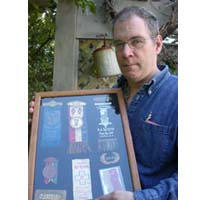Local man writes novel despite Parkinson's
 |
| Robert F. Morrow Jr. at his Henderson Road home with his great-great grandfather Pvt. William A. Baker’s medals. (Photo by Linda Carman) |
 |
| Robert F. Morrow Jr. at his Henderson Road home with his great-great grandfather Pvt. William A. Baker’s medals. (Photo by Linda Carman) |
| If you would like to contribute information on this article, contact us at info@iberkshires.com. |